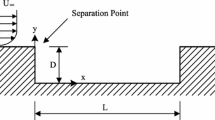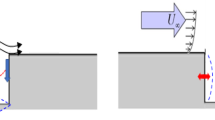Abstract
The current study is focused on examining the effect of the cavity width and side walls on the self-sustained oscillation in a low Mach number cavity flow with a turbulent boundary layer at separation. An axisymmetric cavity geometry is employed in order to provide a reference condition that is free from any side-wall influence, which is not possible to obtain with a rectangular cavity. The cavity could then be partially filled to form finite-width geometry. The unsteady surface pressure is measured using microphone arrays that are deployed on the cavity floor along the streamwise direction and on the downstream wall along the azimuthal direction. In addition, velocity measurements using two-component Laser Doppler Anemometer are performed simultaneously with the array measurements in different azimuthal planes. The compiled data sets are used to investigate the evolution of the coherent structures generating the pressure oscillation in the cavity using linear stochastic estimation of the velocity field based on the wall-pressure signature on the cavity end wall. The results lead to the discovery of pronounced harmonic pressure oscillations near the cavity’s side walls. These oscillations, which are absent in the axisymmetric cavity, are linked to the establishment of a secondary mean streamwise circulating flow pattern near the side walls and the interaction of this secondary flow with the shear layer above the cavity.

























Similar content being viewed by others
References
Adrian JR (1979) Conditional eddys in isotropic turbulence. Phys Fluids 22:2065–2070
Adrian JR (1983) Fluid mechanics measurements, chap 5: laser velocimetry. Taylor and Francis, Bristol, pp 157–159
Ahuja KK, Mendoza J (1995) Effects of cavity dimensions, boundary layer, and temperature on cavity noise with emphasis on benchmark data to validate computational aeroacoustic codes. Contractor report 4653, National Aeronautics and Space Administration
Ashcroft G, Zhang X (2005) Vortical structures over rectangular cavities at low speed. Phys Fluids 17(015104):1–8
Block PJW (1976) Noise response of cavities of varying dimensions at subsonic speeds. Technical notes D-8351, National Aeronautics and Space Administration
Bres GA, Colonius T (2008) Three-dimensional instability in compressible flow over open cavities. J Fluid Mech 599:309–339
Cattafesta L, Williams D, Rowley C, Alvi F (2003) Review of active control of flow-induced cavity resonance. AIAA paper 2003–3567
Charwat AF, Roos JN, Dewey FC, Hitz JA (1961) An investigation of separated flows. Part 1. The pressure field. J Aerosp Sci 28:457–470
Faure TM, Pastur L, Lusseyran F, Fraigneau Y, Bisch D (2009) Three-dimensional centrifugal instabilities development inside a parallelepipedic open cavity of various shape. Exp Fluids 47:395–410
Gharib M, Roshko AF (1987) The effect of flow oscillations on cavity drag. J Fluid Mech 177:501–530
Grace SM, Dewar GW, Wroblewski DE (2004) Experimental investigation of the flow characteristics within a shallow wall cavity for both laminar and turbulent upstream boundary layers. Exp Fluids 36:791–804
Guezennec YG (1989) Stochastic estimation of coherent structures in turbulent boundary layer. Phys Fluids A 1:1054–1060
Larcheveque L, Sagaut P, Le T, Comte P (2004) Large-eddy simulation of a compressible flow in a 3-D open cavity at high Reynolds number. J Fluid Mech 516:265–301
Martin WW, Naudascher E, Padmanabhan M (1975) Fluid-dynamic excitation involving flow instability. J Hydraul Div, Am Soc Civ Eng 101(HY6):681–698
Maull DJ, East LF (1963) Three-dimensional flow in cavities. J Fluid Mech 16:620–632
Migeon C (2002) Details on the start-up development of the Taylor-Gortler-like vortices inside a square-section lid-driven cavity for 1,000 ≤ Re ≤ 3,200. Exp Fluids 33:594–602
Morris SC, Foss JF (2003) Turbulent boundary layer to single-stream shear layer: the transition region. J Fluid Mech 494:187–221
Murray N, Ukeiley L (2003) Estimation of the flow field from surface pressure measurements in an open cavity. AIAA J 41(5):969–972
Murray N, Ukeiley L (2007) Modified quadratic stochastic estimation of resonating subsonic cavity flow. J Turbul 8(53):1–14
Najm HN, Ghoniem AF (1991) Numerical simulation of the convective instability in a dump combustor. AIAA J 29(6):911–919
Ozsoy E, Rambaud P, Riethmuller ML (2005) Vortex characteristics in laminar cavity flow at very low Mach number. Exp Fluid 38:133–145
Plumbee HE, Gibson JS, Lassiter LW (1962) A theoretical and experimental investigation of the acoustic response of cavities in an aerodynamic flow. Technical report WADD-TR-61–75, US Air Force
Rockwell D (1977) Prediction of oscillation frequencies for unstable flow past cavities. J Fluids Eng 199:294–300
Rockwell D, Knisely C (1980) Observations of the 3-D nature of unstable flow past a cavity. Phys Fluids 23(3):425–431
Rockwell D, Naudascher E (1978) Review: self-sustaining oscillations of flow past cavities. Trans ASME: J Fluids Eng 100:152–165
Rossiter JE (1964) Wind-tunnel experiments on the flow over rectangular cavities at subsonic and transonic speeds. Technical report 3438, aeronautical research council reports and memoranda
Rowley CW, Williams DR (2006) Dynamics and control of high-Reynolds-number flow over open cavities. Annu Rev Fluid Mech 38:251–276
Rowley CW, Colonius T, Basu AJ (2002) On self-sustained oscillations in 2-D compressible flow over rectangular cavities. J Fluid Mech 455:315–346
Sarohia V (1977) Experimental investigation of oscillations in flows over shallow cavities. AIAA J 15(7):984–991
Shankar PN, Deshpande MD (2000) Fluid mechanics in the driven cavity. Annu Rev Fluid Mech 32:93–136
Ukeiley L, Murray N (2005) Velocity and surface pressure measurements in an open cavity. Exp Fluids 38:656–671
Zhang K, Naguib AM (2006) Dispersion relation and mode selectivity in low-mach-number cavity flows. AIAA paper 2006–3229
Zhang K, Naguib AM (2008) Effect of cavity width on the unsteady pressure in a low-mach-number cavity. AIAA J 46(7):1878–1880
Acknowledgments
This work was sponsored by a grant through the National Science Foundation (grant number CTS-0425374). Any opinions, findings, and conclusions or recommendations expressed in this material are those of the authors and do not necessarily reflect the views of the National Science Foundation. The leading author is also grateful for the support by Zonta International through the Amelia Earhart fellowship.
Author information
Authors and Affiliations
Corresponding author
Rights and permissions
About this article
Cite this article
Zhang, K., Naguib, A.M. Effect of finite cavity width on flow oscillation in a low-Mach-number cavity flow. Exp Fluids 51, 1209–1229 (2011). https://doi.org/10.1007/s00348-011-1142-y
Received:
Revised:
Accepted:
Published:
Issue Date:
DOI: https://doi.org/10.1007/s00348-011-1142-y




